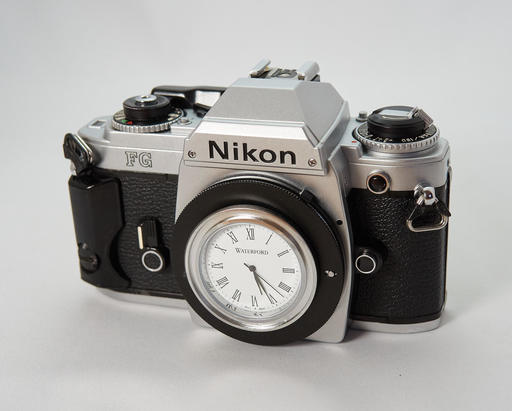The Olympus OM-D E-M5 Mark II combined with the Panasonic Leica DG Summilux 25mm f/1.4 II ASPH. lens is an ideal combination for the product photography I do daily for TheFilmCameraShop. I've tried many different setups over the years, and this one has just the right amount of everything.
 A Nikon FG Analog Clock for desk or bookshelf. Photographed with my MFT rig and listed in TheFilmCameraShop.
A Nikon FG Analog Clock for desk or bookshelf. Photographed with my MFT rig and listed in TheFilmCameraShop.
Before I go any further, let me take a couple steps back. When I was a photography apprentice for a professional who graduated from Brooks, we used to spend hours setting up product shots. He taught me about softboxes, reflectors, and the tricks of the trade to create images that clients liked. That was great for then, but it's a luxury that I don't have today.
Now, I run an online shop and must work quickly. I leave a mini-studio permanently set up in the shooting room. Once I finish restoring a product for the shop, I photograph it and list for sale. As quickly as I currently work, it still feels like this phase takes too long. Such is life these days, right?
 A Nikon FG Analog Clock for desk or bookshelf. Photographed with my MFT rig and listed in TheFilmCameraShop.
A Nikon FG Analog Clock for desk or bookshelf. Photographed with my MFT rig and listed in TheFilmCameraShop.
That being said, my Micro Four Thirds camera saves me a lot of time. First of all, I don't have to use a tripod. This is huge, time wise. Before, when we were shooting full frame (or medium format!), we had to stop down the aperture and focus very precisely because of the shallow depth of field that results from larger sensors and wide apertures. As a result, I had to break out the 3-legged beast.
What's so beautiful about my mirrorless rig is that I can shoot at f/4.5 or so (thanks to the depth of field), raise the ISO to 1600, and lean a bit on the sensor-based image stabilization. This allows me to handhold the camera, saving lots of time while still providing excellent results. The MFT sensor gives me that little bit of extra depth of field that's so important in product photography. I love it. And this is something that I also enjoy with certain types of portrait work as well.
Secondly, the realtime exposure compensation feedback makes it easy to nail the exposure during capture. (Very important for brightly-lit white backgrounds!) As a result, I have virtually no post production time. Again, this is a big deal on busy days. Thanks to the sharpness of the Leica lens and the accuracy or the E-M5 Mark II, the files virtually go from camera to product page.
When I'm not in the studio, and am wearing my Nimble Photographer hat, I often depend on Micro Four Thirds photography for traveling light. The real savings is realized with the lenses that are so compact and sharp.
But over the last few years, I've come to appreciate this format for online product photography as well. And in this case, it's the bottom line that's enhanced because efficiency is improved.
No doubt Micro Four Thirds photography is awesome for travel. But I've learned that it's darn good for business as well.
There are product links in this article that contain affiliate tags. In some cases, depending on the product, The Digital Story may receive compensation if you purchase a product via one of those links. There is no additional cost to you.
You can share your thoughts at the TDS Facebook page, where I'll post this story for discussion.











